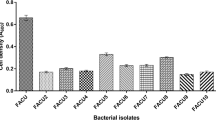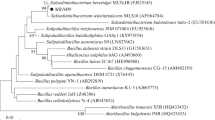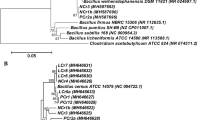Abstract
Pseudomonas fluorescens LB300 is a chromateresistant strain isolated from chromium-contaminated river sediment. Chromate resistance is conferred by the plasmid pLHB1. Strain LB300 grew in minimal salts medium with as much as 1000 μg of K2CrO4 ml−1, and actively reduced chromate to Cr(III) while growing aerobically on a variety of substrates. Chromate was also reduced during anaerobic growth on acetate, the chromate serving as terminal electron acceptor. P. fluorescens LB303, a plasmidless, chromatesensitive variant of P. fluorescens LB300, did not grow in minimal salts medium with more than 10 μg of K2CrO4 ml−1. However, resting cells of strain LB303 grown without chromate reduced chromate as well as strain LB300 cells grown under the same conditions. Furthermore, resting cells of chromate-sensitive Pseudomonas putida strain AC10, also catalyzed chromate reduction. Evidently chromate resistance and chromate reduction in these organisms are unrelated. Comparison of the rates of chromate reduction by chromate grown cells and cells grown without chromate indicated that the chromate reductase activity is constitutive. Studies with cell-free extracts show that the reductase is membrane-associated and can mediate the transfer of electrons from NADH to chromate.
Similar content being viewed by others
References
Bopp LH, Chakrabarty AM, Ehrlich HL (1983) Chromate resistance plasmid in Pseudomonas fluorescens. J Bacteriol 155:1105–1109
Clarke PH, Ornston LN (1975) Metabolic pathways and regulation: I. In: Clarke PH, Richmond MH (eds) Genetics and biochemistry of Pseudomonas. John Wiley and Sons, New York, pp 91–261
Gruber JE, Jennette KW (1978) Metabolism of the carcinogen chromate by rat liver microsomes. Biochem Biophys Res Commun 82:700–706
Gvozdyak PI, Mogilevich NF, Ryl'skii AF, Grishchenko NI (1986) Reduction of hexavalent chromium by collection strains of bacteria. Mikrobiologiya 55:962–965
Horitsu H, Futo S, Miyazawa Y, Ogai S, Kawai K (1987) Enzymatic reduction of hexavalent chromium by hexavalent-chromium tolerant Pseudomonas ambigua G-1. Agric Biol Chem 51:2417–2420
Kvasnikov EI, Stepanyuk VV, Klyushnikova TM, Serpokrylov NS, Simonova GA, Kasatkina TP, Pachenko LP (1985) A new chromium-reducing, gram-variable bacterium with mixed type flagellation. Mikrobiologiya 54:83–88
Lebedeva EV, Lyalikova NN (1979) Reduction of crocoite by Pseudomonas chromatophila sp. nov. Mikrobiologiya 48:517–522
Mearns AJ, Oshida PS, Sherwood MJ, Young DR, Reish DJ (1976) Chromium effects on coastal organisms. J Water Poll Control Fed 48:1929–1939
Nishioka H (1975) Mutagenic activities of metal compounds in bacteria. Mutat Res 31:185–190
Ohtake H, Cervantes C, Silver S (1987) Decreased chromate uptake in Pseudomonas fluorecens carrying a chromate resistance plasmid. J Bacteriol 169:3853–3856
Petrilli FL, DeFlora S (1977) Toxicity and mutagenicity of hexavalent chromium on Salmonella typhimurium. Appl Environ Micribiol 33:805–809
Romanenko VI, Koren'kov VN (1977) A pure culture of bacteria utilizing chromates and bichromates as hydrogen acceptors in growth under anaerobic conditions. Mikrobiologiya 46:414–417
Sittig M (1985) Handbook of Toxic and Hazardous Chemicals and Carcinogens. Noyes Publications, Park Ridge, NJ, pp 243–248
Trimble RB, Ehrlich HL (1968) Bacteriology of manganese nodules. III. Reduction of MnO2 by two strains of nodule bacteria. Appl Microbiol 16:695–702
Troshanov EP (1969) Conditions affecting the ability of micro-organisms to reduce iron and manganese in ore-bearing lakes of the Karelian Isthmus. Mikrobiologiya 38:634–643
Venitt S, Levy LS (1974) Mutagenicity of chromates in bacteria and its relevance to carcinogenesis. Nature (Lond) 250:493–495
Author information
Authors and Affiliations
Rights and permissions
About this article
Cite this article
Bopp, L.H., Ehrlich, H.L. Chromate resistance and reduction in Pseudomonas fluorescens strain LB300. Arch. Microbiol. 150, 426–431 (1988). https://doi.org/10.1007/BF00422281
Received:
Accepted:
Issue Date:
DOI: https://doi.org/10.1007/BF00422281




